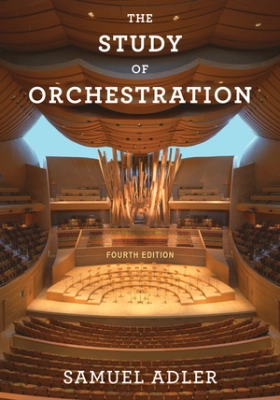Opens in a new window
W.W. Norton & Co. Inc The Study of Orchestration (quatrième édition) – Adler – Livre avec fichiers audio et vidéo en ligne

Votre prix: $190.00 CDN
ou à partir de $28 CDN/mo
- Composition/conception : ADLER, SAMUEL
- Instrumentation : TEXT
- Numéro de modèle : 9780393600520
Support : Livre avec fichiers audio et vidéo en ligne
Sujet : Orchestration
Le livre qui a établi la norme pour les ouvrages sur l’orchestration.
Écrit par un compositeur de renom dont les œuvres ont été interprétées par les plus grands orchestres du monde, « The Study of Orchestration » est le seul livre qui explore les caractéristiques des instruments d’orchestre et montre aux élèves comment un maître compositeur aborde l’orchestration. La quatrième édition invite les élèves à expérimenter les instruments grâce à des enregistrements audio et vidéo en ligne et offre désormais une meilleure couverture de l’écriture pour l’orchestre. L’accès aux enregistrements est inclus dans chaque nouvel exemplaire.
Le seul ouvrage qui invite les élèves à écouter
L’étude de l’orchestration est accompagnée d’enregistrements audio et vidéo complets (mettant en scène des musiciens de l’Eastman School of Music) qui éclairent les techniques que les élèves rencontrent dans le livre. L’accès aux enregistrements audio et vidéo est inclus sans frais supplémentaires dans chaque nouvel exemplaire et est valable pendant 360 jours.
L’introduction la plus complète aux instruments et techniques d’orchestre
La quatrième édition comprend une vue d’ensemble magistrale de chaque instrument et de ses techniques, une référence que les élèves utiliseront chaque fois qu’ils arrangeront ou composeront. Chaque technique est illustrée par des exemples tirés de la littérature, et un ensemble audio et vidéo révolutionnaire permet aux élèves d’entendre et de voir chaque instrument. Cette édition propose également une mise à jour de la couverture des instruments à percussion et une nouvelle section sur l’accordéon.
Le seul livre qui montre aux élèves comment écrire pour un groupe et un orchestre
L’étude de l’orchestration est le seul livre qui relie les informations sur les instruments à ce que font les élèves en matière de composition et d’arrangement. Cette nouvelle édition du livre et du cahier d’exercices offre une couverture supplémentaire de la musique pour harmonie. Les sections « Orchestration in Action » à la fin de chaque chapitre présentent le maître compositeur et enseignant Samuel Adler qui présente ses propres compositions et montre comment les orchestrer.
Offre les meilleures possibilités de pratiquer l’orchestration
Un ensemble de supports solides offre aux élèves de nombreuses possibilités de révision et d’autoévaluation. La quatrième édition propose de nouveaux exercices plus simples, accessibles aux élèves de tous niveaux. Le cahier d’exercices offre plus de matériel qu’il n’en faut pour n’importe quel cours d’orchestration, de sorte que les pédagogues peuvent sélectionner les exercices qui répondent le mieux aux besoins de leurs élèves.
Contenu (en anglais) :
• Part 1. Instrumentation
• 1. The Orchestra--Yesterday and Today
• 2. Bowed String Instruments
• Construction
• Tuning
• Fingering
• Double, Triple, and Quadruple Stops
• Divided Strings
• Vibrato
• Glissando and Portamento
• The Bow
• Bowing
• Special On-the-String Bowings
• Special Off-the-String Bowings
• Trills and Other Coloristic Effects Using the Bow
• Colouristic Effects without the Bow
• Mutes
• Scordatura
• Harmonics
• Contemporary String Techniques
• 3. Individual Bowed String Instruments
• Violin
• Viola
• Violoncello or Cello
• Double Bass
• 4. Plucked String Instruments
• Harp
• Guitar
• Mandolin
• Banjo
• Zither
• 5. Scoring for Strings
• Individuality within the Ensemble
• Foreground--Middleground--Background
• Contrapuntal Writing for Strings
• Homophonic Writing for Strings
• Using the String Choir to Accompany a Soloist
• Transcribing from Piano to Strings
• 6. The Woodwind Choir (Reed Aerophones)
• Construction
• Classifying Woodwind Instruments
• The Principle of Transposition
• Playing Techniques
• The Woodwind Section of a Symphony Orchestra
• Scoring for Woodwind Instruments
• 7. Individual Woodwinds
• Flute
• Piccolo
• Alto Flute
• Bass Flute
• Oboe
• English Horn
• Other Members of the Oboe Family
• Clarinet
• “Piccolo” Clarinet: Clarinet in D or E-flat
• Bass Clarinet
• Others Members of the Clarinet Family
• Saxophone
• Bassoon
• Contrabassoon
• 8. Scoring for Woodwinds and Woodwind-String Combinations
• The Role of Winds in the Symphony Orchestra
• The Variety of Orchestral Treatments
• Homophonic Writing for Winds
• Contrapuntal Writing for Winds
• Using the Wind Choir to Provide a Contrasting Color
• Using the Wind Choir to Double Other Instruments of the Orchestra
• New Types of Articulations For Woodwinds
• Special Effects
• Transcribing from Piano to Winds and Strings
• 9. Introduction to Brass Instruments
• Composition of the Brass Section
• Brass Instruments and the Written Orchestral Score
• Overblowing and the Principle of the Harmonic Series
• Crooks, Valves, and Slides
• Range
• Tone Production, Articulation, and Tonguing
• Common Characteristics and Effects on All Brass Instruments
• Mutes
• Muting Devices Other Than Mutes
• 10. Individual Brass Instruments
• Horn
• Trumpet
• Cornet
• Other Members of the Trumpet Family
• Trombone
• Other Members of the Trombone Family
• Tuba
• Other Members of the Tuba Family
• 11. Scoring for Brass, and Brass Combined with Strings and Winds
• Early Uses of the Brass Choir
• Doubling of Brass Instruments within the Modern Orchestra
• Homophonic Writing for the Brass Choir
• Using the Brass Choir to Present the Melody
• Contrapuntal Writing for the Brass Choir
• Climactic Uses of the Brass Choir
• Using the Brass Choir to Provide a Colouristic Effect
• 12. The Percussion Ensemble
• Historical Uses of Percussion Instruments within the Orchestra
• Number and Distribution of Percussion Players
• Notation of Percussion Instruments
• Mallets, Beaters, and Sticks
• Categories of Percussion Instruments
• Instruments of Definite Pitch
• Instruments Of Indefinite Pitch
• 13. Keyboard Instruments
• Piano
• Celesta
• Harpsichord
• Organ
• Harmonium
• 14. Scoring for Percussion with Keyboard Alone or in Combination
• Percussion Layout in the Full Score
• Percussion Section Setup
• Uses of the Percussion Section
• Part 2. Orchestration
• 15. Scoring for Orchestra
• The Unison-Octave Tutti
• The Distribution of Foreground--Middleground--Background Elements within the Orchestra
• Orchestrating a Melody or Primary Gesture
• Using the Orchestra to Create Special Effects
• 16. The Orchestra as Accompanist
• The Concerto
• Accompanying the Vocal Soloist, Ensemble, or Chorus
• 17. Transcribing for Orchestra
• Transcribing from Keyboard or Small Chamber Combinations to Orchestra
• Transcribing from Band or Wind Ensemble to Orchestra
• Transcribing to Various Available Instrumental Combinations
• 18. The Preparation of Score and Parts
• The Orchestral Score Setup
• The Reduced Score
• The Condensed Score
• Preparing Individual Parts
• 19. Scoring for Band or Wind Ensemble
• Scoring for Band
• Band Versus Wind Ensemble
• The Percussion Section within the Band or Wind Ensemble
• The Band and Wind Ensemble Score Setup
• Condensed Score
• Transcribing from Orchestra to Band or Wind Ensemble
Q et R
There are currently no questions for this product.
Avis
Il n'y a actuellement aucun commentaire sur ce produit.




